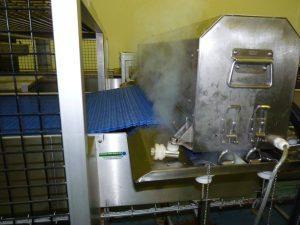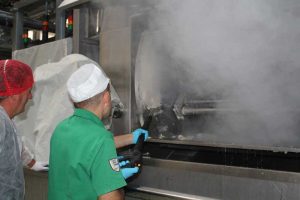In the ever-evolving landscape of industrial processes, conveyor washing systems have emerged as a pivotal innovation, streamlining the cleaning of various components and products. These systems are designed to automate the washing process, significantly enhancing efficiency and productivity in manufacturing and processing environments. By integrating conveyor technology with advanced washing mechanisms, industries can ensure that their products are not only clean but also meet stringent hygiene standards.
This is particularly crucial in sectors such as food processing, pharmaceuticals, and automotive manufacturing, where cleanliness is paramount. The concept of conveyor washing systems is rooted in the need for consistency and reliability in cleaning operations. Traditional manual washing methods can be labour-intensive and prone to human error, leading to inconsistencies in cleanliness and potential contamination.
In contrast, conveyor washing systems offer a systematic approach, where items are continuously moved through a series of washing stages, ensuring thorough cleaning without the variability associated with manual processes. As industries strive for greater efficiency and compliance with health regulations, the adoption of these systems has become increasingly prevalent.
Summary
- Conveyor washing systems are an efficient and effective way to clean and sanitise items as they move along a conveyor belt.
- Using conveyor washing systems can lead to increased productivity, reduced labour costs, and improved hygiene standards.
- There are various types of conveyor washing systems available, including spray washers, immersion washers, and rotary drum washers.
- When choosing a conveyor washing system, it’s important to consider factors such as the type of items being washed, production volume, and space constraints.
- Regular maintenance and upkeep of conveyor washing systems is essential to ensure optimal performance and longevity.
Benefits of Using Conveyor Washing Systems
The advantages of conveyor washing systems are manifold, making them an attractive option for businesses looking to optimise their cleaning processes. One of the most significant benefits is the enhancement of operational efficiency. By automating the washing process, companies can reduce the time and labour required for cleaning tasks.
This not only frees up valuable human resources for more complex tasks but also allows for a more consistent output, as the system can operate continuously without breaks. Moreover, conveyor washing systems contribute to improved product quality. In industries where cleanliness is critical, such as food production or pharmaceuticals, these systems ensure that every item is subjected to the same rigorous cleaning standards.
This uniformity helps to eliminate the risk of contamination and ensures that products meet regulatory requirements. Additionally, the use of advanced technologies in these systems often allows for the use of less water and cleaning agents, promoting sustainability while maintaining high standards of cleanliness.
Types of Conveyor Washing Systems

Conveyor washing systems come in various forms, each tailored to meet specific cleaning needs and industry requirements. One common type is the spray washer, which utilises high-pressure jets of water and cleaning solutions to remove contaminants from surfaces. This type is particularly effective for items with complex geometries or those that require thorough cleaning without disassembly.
Spray washers can be customised with different nozzle configurations to target specific areas, ensuring comprehensive coverage. Another prevalent type is the immersion washer, where items are submerged in a tank filled with cleaning solution. This method is ideal for parts that can withstand being fully immersed and is particularly effective for removing stubborn residues.
Immersion washers often incorporate agitation mechanisms to enhance cleaning efficiency further. Additionally, there are ultrasonic washers that use high-frequency sound waves to create microscopic bubbles in a cleaning solution, which implode and dislodge dirt and contaminants from surfaces. Each type of conveyor washing system offers unique advantages, allowing businesses to select the most suitable option based on their specific cleaning requirements.
Choosing the Right Conveyor Washing System for Your Needs
| Factors to Consider | Conveyor Washing System |
|---|---|
| Conveyor Type | Continuous or batch |
| Material Handling | Size, weight, and shape of items being washed |
| Cleaning Requirements | Level of cleanliness needed |
| Water Usage | Efficiency and conservation measures |
| Space Availability | Footprint and layout of the facility |
| Automation | Manual, semi-automatic, or fully automatic operation |
Selecting the appropriate conveyor washing system requires careful consideration of several factors. First and foremost, businesses must assess the nature of the items being cleaned. The size, shape, and material composition of the products will significantly influence the choice of system.
For instance, delicate components may require a gentler approach, such as ultrasonic cleaning, while robust parts may benefit from high-pressure spray washing. Another critical aspect to consider is the volume of items that need to be processed. High-throughput operations may necessitate a more extensive system capable of handling large quantities efficiently.
Additionally, businesses should evaluate their specific cleaning requirements, including the types of contaminants present and any regulatory standards that must be met. By thoroughly analysing these factors, companies can make informed decisions that align with their operational goals and ensure optimal performance from their conveyor washing systems.
Maintenance and Upkeep of Conveyor Washing Systems
To ensure longevity and optimal performance, regular maintenance and upkeep of conveyor washing systems are essential. Routine inspections should be conducted to identify any wear and tear on components such as pumps, nozzles, and conveyor belts. Addressing minor issues promptly can prevent more significant problems down the line and minimise downtime in production processes.
Furthermore, it is crucial to maintain the cleanliness of the washing system itself. Residue build-up can compromise the effectiveness of the cleaning process and lead to contamination of products. Implementing a scheduled cleaning regimen for the conveyor washing system will help maintain its efficiency and ensure that it continues to meet hygiene standards.
By prioritising maintenance and upkeep, businesses can maximise their investment in conveyor washing technology and enhance overall operational efficiency.
Environmental Considerations in Conveyor Washing Systems

As industries become increasingly aware of their environmental impact, conveyor washing systems have evolved to incorporate sustainable practices. One significant consideration is water usage; modern systems are designed to minimise water consumption while still achieving effective cleaning results. Technologies such as recirculation systems allow for the reuse of water within the washing process, significantly reducing overall water waste.
Additionally, many conveyor washing systems now utilise eco-friendly cleaning agents that are biodegradable and less harmful to the environment. This shift not only aligns with regulatory requirements but also reflects a growing commitment among businesses to adopt sustainable practices. By prioritising environmental considerations in their operations, companies can enhance their corporate social responsibility profile while also potentially reducing operational costs associated with waste disposal and resource consumption.
Case Studies of Successful Implementation of Conveyor Washing Systems
Numerous industries have successfully implemented conveyor washing systems, reaping significant benefits in terms of efficiency and product quality. For instance, a leading food processing company faced challenges with manual cleaning methods that were time-consuming and inconsistent. By integrating a state-of-the-art conveyor washing system into their operations, they were able to reduce cleaning times by over 50%, allowing for increased production capacity while ensuring compliance with stringent hygiene standards.
In another case study within the automotive sector, a manufacturer struggled with residue build-up on components during assembly processes. The introduction of an immersion conveyor washing system not only resolved this issue but also improved overall product quality by ensuring that all parts were thoroughly cleaned before assembly. The result was a marked decrease in defects and rework costs, demonstrating how effective cleaning solutions can have a profound impact on operational success.
Future Trends in Conveyor Washing Systems Technology
As technology continues to advance at a rapid pace, the future of conveyor washing systems looks promising. One emerging trend is the integration of smart technology and automation into these systems. With the advent of Industry 4.0, manufacturers are increasingly adopting IoT-enabled devices that allow for real-time monitoring and data analysis.
This capability enables businesses to optimise their cleaning processes further by identifying inefficiencies and making data-driven decisions. Moreover, advancements in materials science are leading to the development of more durable and efficient components for conveyor washing systems. Innovations such as self-cleaning surfaces and advanced filtration systems are set to enhance performance while reducing maintenance requirements.
As industries continue to prioritise sustainability and efficiency, it is likely that we will see even more innovative solutions emerge in the realm of conveyor washing technology, paving the way for cleaner and more efficient manufacturing processes in the years to come. In conclusion, conveyor washing systems represent a significant advancement in industrial cleaning technology, offering numerous benefits across various sectors. By understanding their advantages, types, maintenance needs, environmental considerations, successful implementations, and future trends, businesses can make informed decisions that enhance their operational efficiency while ensuring compliance with hygiene standards.
As we move forward into an increasingly automated future, these systems will undoubtedly play a crucial role in shaping cleaner and more efficient manufacturing processes worldwide.
FAQs
What are conveyor washing systems?
Conveyor washing systems are automated systems used to clean and sanitise items as they move along a conveyor belt. These systems are commonly used in industries such as food processing, automotive manufacturing, and pharmaceuticals.
How do conveyor washing systems work?
Conveyor washing systems typically use a combination of water, detergents, and high-pressure jets to clean items as they pass through the system on a conveyor belt. The system may also include brushes, air knives, and drying tunnels to ensure thorough cleaning and drying.
What are the benefits of using conveyor washing systems?
Conveyor washing systems offer several benefits, including increased efficiency, consistent cleaning results, reduced labour costs, and improved hygiene and sanitation. These systems can also help to prolong the lifespan of equipment and reduce the risk of contamination in production processes.
What types of items can be cleaned using conveyor washing systems?
Conveyor washing systems can be used to clean a wide range of items, including components, parts, containers, packaging, and products. These systems are versatile and can be customised to suit the specific cleaning requirements of different industries.
Are conveyor washing systems environmentally friendly?
Many conveyor washing systems are designed to be environmentally friendly, using water and detergents efficiently and incorporating water recycling and filtration systems to minimise waste. Some systems also use biodegradable detergents to reduce their environmental impact.










